Geiger Counter Program
CNS IONISING RADIATION WORKSHOP
The CNS ECC Ionizing Radiation workshop material will be maintained on this website. No further presentations are planned. It is entitled Embrace NORM (NORM = Naturally Occurring Radioactive Material) and is intended for high school senior science teachers. The Workshop includes aids for teachers on radioactive decay and fission. It introduces:
- the Canadian Nuclear Association’s internet resource for the Canada-wide Science Curriculum;
- the Canadian Nuclear Safety Commission Educational Resources;
- the Interactive Chart of the Nuclides a valuable internet resource providing data on over 3000 nuclides (web address changed 2020 October);
- classroom experiments are conducted with a sensitive Geiger-Müeller Detector using NORM source materials and consumer products to provide teachers and students with real, personal experience with ionising radiation. Teachers who have a lower-sensitivity Geiger instrument at hand may find this note on using low-sensitivity Geigers with the workshop experiments useful.
The most recent workshop notes and presentation files are available for download (right click and save as).
Workshop notes (PDF) (Version 2.0 2018-02-07) Includes the Hot Balloon experiment!
Power Point Presentations (2018-02-08)
- Embrace Norm: Introduction & Orientation (4.6 MB)
- Embrace Norm: Theory (5.7 MB)
- Embrace Norm: Detecting Ionising Radiation (2.8 MB)
- Embrace Norm: Experiments (14 MB)
Recommended Links for Educators and Students (PDF) (revised 2018-02-13)
In creating this workshop, the CNS ECC collaborated with a retired teacher in Ontario and a working teacher in Alberta. Renfrew County District School Board science teachers helped evaluate the CNS ECC approach. Feedback from workshop presenters and attendees have resulted in many changes to this workshop.The full scope of this workshop requires 90 minutes. Many presentation opportunities are constrained to less than 60 minutes. The content has been broken into segments to provide sufficient time for the teachers to gain hands-on experience with the Geiger system for a given event.
The CNS ECC intends to provide more video segments for the workshop content.
News
CNS Geiger Kits Vernier have updated their Graphical Analysis 4 software
With the sponsorship of the Canadian Nuclear Safety Commission, the CNS has completed 40 new Geiger Kits based on the Vernier GDX-RAD (Go Direct Radiation Monitor) in 2 lots: late 2019 and early 2020. These have been modified to substitute a larger window LND 7313 tube (in place of the smaller LND 712). The modified instrument provides performance similar to that of the Aware Electronics RM-80 or Black Cat Systems GM-45 included in previous CNS Geiger Kits. With additional sponsorship from the CNSC the a second set of 40 new Geiger Kits has been completed: 23 new Geiger Kits were shipped to teachers from St John’s Newfoundland to Victoria BC and north to Yellowknife in November and December. An additional 5 new Kits have been sent this through the spring to 1 NB school and 4 BC schools. The remaining 14 Kits have not been allocated. High School Science teachers at Canadian high schools are invited to contact the CNS if they are interested in receiving a Kit.
The GDX-RAD is accessed via USB or Bluetooth® using the free Vernier APP Graphical Analysis 4 available for Windows PC, Mac, Chromebook, iPhone, iPad, and Android phone / tablet. Moreover, the APP detects the device system language and supports over 30 languages. Vernier have software updates on their website and at the Apple APP, and Google Play stores. Chromebook users should use the free Chromestore link on the Vernier website. DO NOT use the Android APP with a Chromebook.
IAEA APPs for Chart of the Nucldies
The International Atomic Energy Agency has developed Chart of the Nuclides APPS that are available for free on the iPhone / iPad APP store and the Android phone / tablet APP store. We have confirmed that the Android APP will work on Chromebooks. Testing has shown that if the Chromebook display is set to “small,” such as 1518 x 853 (instead of the native 1366 x 768 for the Asus device used) the “Element” display is easily used by moving the window — 2 fingers on the touch pad. We’re working on videos for these.
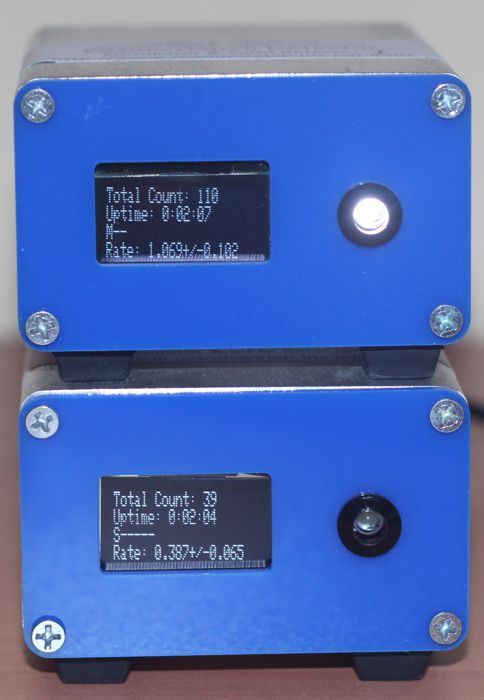
These scintillator-based detectors may be stacked vertically with one of them slaved to the “master” to detect coincident events. The majority of the coincident events result from muons generated by cosmic rays interacting with the earth’s atmosphere. The white led flashes when a detection event occurs. The displays show that the slave (lower unit) detected 39 counting events “coincident” with the master (upper unit) detecting 110 counts in the same nominal interval. The sensitivity of the 2 detectors has been adjusted (a software parameter) to provide comparable count values with the instruments side by side and not master/slaved.
Aware Electronics interface cable connector problem
CAUTION FOR USB-MSP INTERFACE USERS! Please leave your USB cable connected to the interface. One interface was retuned to the CNS with the mini USB connector extracted from the interface and stuck on the mating cable connector. The damaged interface is not repairable.
Potassium Chloride Salt 40K Sources

The CNS Geiger Kits first included NoSalt®. The Windsor Salt Company sells Salt Free / Sans Sel® — an alternative to the more expensive NoSalt® at less than $5 in most grocery stores in Canada. About $1.20 per kBq of 40K! (It may be a special order item in some stores.) Both suppliers also have a “Half Salt” product, — a mix of NaCl and KCl.
The CNS Nu-Salt … (K-40) Fact Sheet has been updated — see below!
Ionisation Radiation Workshop Videos
Check out the CNS IRW YouTube Channel
An article on NORM (reproduced with permission), by B. White of the CNS ECC, was published in STAO’s “Crucible” prior to the 2008 Workshop presentation.
An article entitled “Henri Bequerel, Winner of the 1903 Nobel Prize in Physics: A Change of Hypothesis“ published in Crucible in 2013 is reproduced with permission.
Another article on the Hot Balloon Experiment (reproduced with permission), was published in Crucible prior to the 2011 Workshop presentation at STAO.
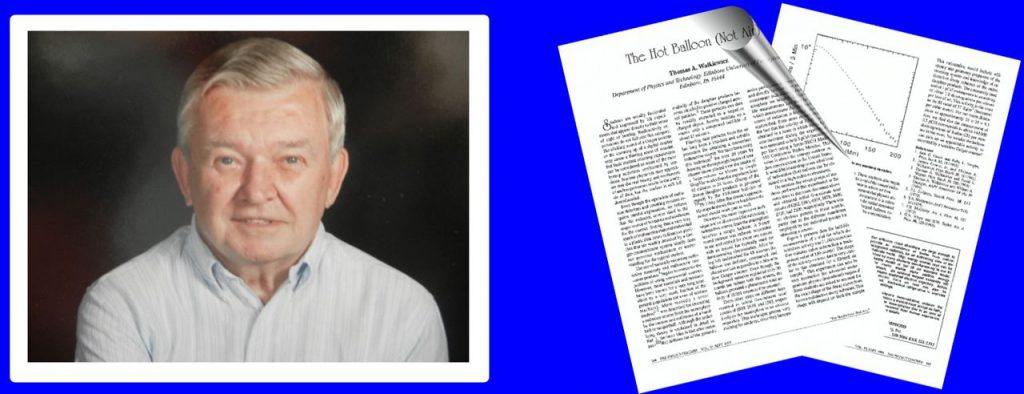
A PDF version of Thomas A. Walkiewicz 1995 paper: “The Hot Balloon (Not Air)” is posted with the permission of The Physics Teacher (American Association of Physics Teachers).
Online Resources re Ionising Radiation
The Jefferson Laboratory has a series of videos on the measurement of the half-life of barium-137 as the Frostbite Theater: Part 1, Part 2, Part 2e, Part 3. Students may collect and analyse the data from the videos.
Tasha Richardson has a website featuring remote access interactive labs for science students (presented a workshop at STAO 2017).
The CNS ionising radiation workshop references the brochures below.
CNS Educational Brochures
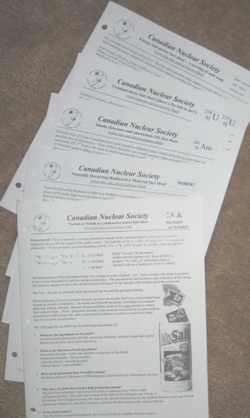
The following CNS educational brochures are available for download:
- Nu-Salt, NoSalt or Salt Free as a radioactive source (2018 February)
- Uranium decay fact sheet (there’s Po-210 in me?) (2018 February)
- Smoke Detectors and Americium-241 (2010 October)
- Compact Fluorescent Lamps – Radioactive or Not? (2011 January )
- Energy and power fact sheet – a serving of unit soup (2010 April)
- Americium-241 vs. Plutonium-239 (2010 April)
Please check back here for the most recent version of these files and new ones.
The French language fact sheets are availalble for download:
- Feuillet éducatif sur succédanés de sel comme source radioactive(2016 octobre)
- Feuillet éducatif sur les substances radioactives naturelles (2010 avril)
- Feuillet éducatif sur la désintégration de l’uranium (du Po-210 en moi ?) (2014 juillet)
- Feuillet éducatif sur les détecteurs de fumée et l’américium-241 (2011 mars)
- Feuillet éducatif sur les ampoules fluorescentes compactes — radioactives, ou pas? (2011 février)
- Feuillet éducatif sur l’énergie et la puissance – et pot-pourri d’unités (2010 avril)
- Feuillet éducatif sur l’américium-241 et le plutonium-239 (2010 avril)
This informative summary of radiation dose information is now hard to find on the internet:
- An enlarged version of USA DOE Office of Science Low-Level Radiation Dose Ranges chart.
Comments or suggestions are most welcome!
CNS Geiger Kit Donations
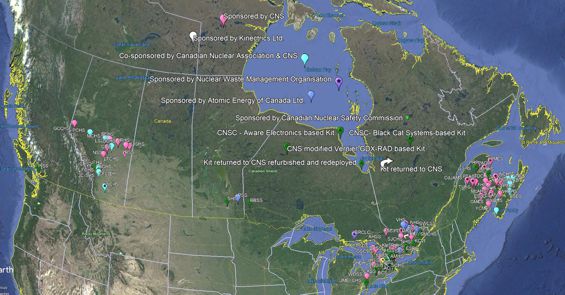
Google Earth Map image (not up to date)
Live Google Map (not up to date)
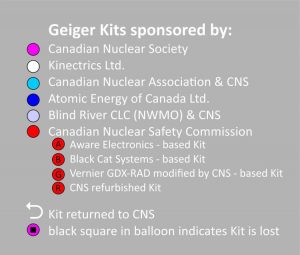
With the support of our sponsors, the CNS has donated Geiger kits to 272 science teachers at Canadian high schools from St John’s NL to Victoria BC as shown in the Google Earth® image & searchable map above (7 of these are considered to be lost). 6 have been returned from schools, refurbished and placed with new schools. Most of the high schools do not reply to our “annual” email polls. We suspect that many of the early CNS Geiger Kits that were limited to use with Windows XP® and Vista® are no longer being used as the computer interface used at that time is not compatible with most more modern computers.
If you requested a CNS Geiger Kit and have not received one it may be due to our having old contact information. Please contact the CNS ECC with an updated request.
The photo below shows a 2020 CNS Geiger Kit with the modified Vernier GDX-RAD.
(The second Geiger in the photo illustrates using a wooden cylinder to support the Geiger atop a small sample container.)
The experience with burning CDs became frustrating in 2018 & 2019 and we have switched to USB flash drives.
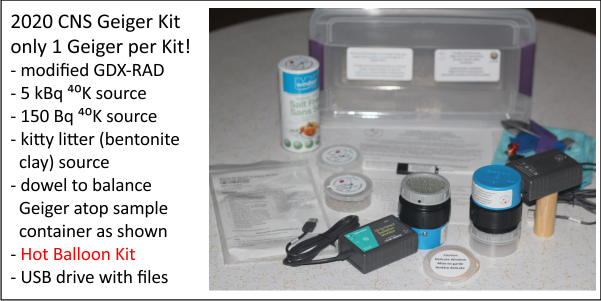
The Vernier Graphical Analysis 4® software for both Windows® and macOS® are included on the drive.
The software for iOS phone / tablets, Android phone / tablets and Chromebooks is available for free download from the respective APP stores.
The CNS provides a “template” file for use when monitoring background levels: “ambl” file for cpm X-axis 60 min Y-axis 100 (auto)
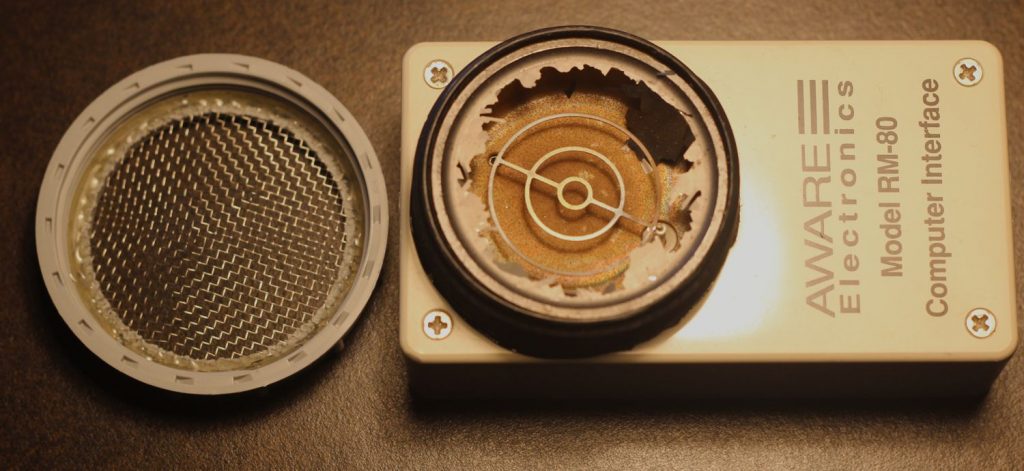
The stainless steel screen used on the CNS-modified GDX-RAD to protect the thin Geiger window is more robust that those previously supplied by Aware Electronics. This change and the introduction of a set screw to secure the gray bushing was made to improve the protection of the windows. A consequence is that the sensitivity is reduced — reducing the count rates for some of the experiments compared to the results obtained with the Aware Electronics GM-40. This modest reduction is most apparent when monitoring an alpha source such as the thoriated camera lens, or the Hot Balloon Experiment. (A broken LND 7313 costs more than $150 US to replace.)
- The Canadian Nuclear Safety Commission sponsored the donation of 15 Geiger Kits in the spring of 2018, 20 Geiger Kits in late 2019 and another 20 Geiger Kits in 2020 as well as the refurbishment and donation of 4 Kits.
- The Nuclear Waste Management Organization sponsored the 3 Geiger Kits supplied to the Blind River Community.
- Atomic Energy of Canada Ltd. sponsored 14 Geiger Kit donations in 2014.
- The Canadian Nuclear Association co-sponsored the 25 donations in 2013.
- Kinectrics Ltd. sponsored 1 donation in 2009. Additional sponsors would be most welcome.
- The balance of the Kits were sponsored by the Canadian Nuclear Society.
If you are a science teacher at a Canadian high school and wish to obtain a Geiger Kit for your school, please contact the CNS. Your request will be added to our list that will be addressed when resources are available. In the interim, if your school is near one of those in the list of schools with Geiger kits, you may be able to borrow one from a colleague. The highlighted schools are the most recent recipients. The Geiger interfaces with a personal computer running most versions of Windows®.
Three of the Kits donated in 2018 and 2019 included Black Cat Systems GM-45 USB Version hardware and software. The software is supplied for both Mac® and PC Windows®. This software provides an alternative presentation of the data on the computer display.
Both Aware Electronics and Black Cat Systems have been unresponsive to our attempts to acquire instruments since 2018 June. The CNS has limited parts available and will continue to support these Kits depending on the type of failure. As of 2020 October the Aware Electronics website is no longer active.
Geiger Kit Updates
Note: if you have updated to Windows® 7+, please contact the CNS for a compatible interface.
If your Aware Electronics interface provided by the CNS look like the one on the left below, it is not compatible!
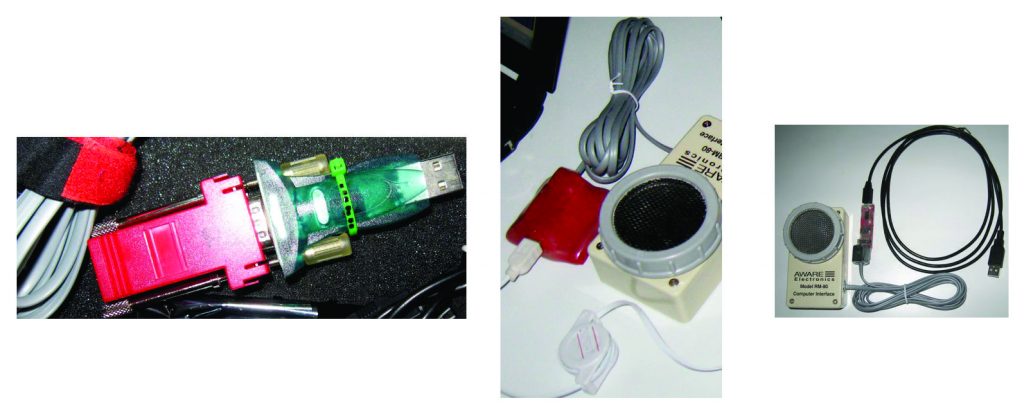
CAUTION FOR Aware Electronics USB-MSP INTERFACES
Please leave your USB cable connected to the interface.
One interface was retuned to the CNS with the mini USB connector extracted
from the interface and stuck on the mating cable connector.
The damaged interface is not repairable.
The CNS Geiger Kits supplied since 2012 included an Aware Electronics RM-80 Geiger detector with a protective cover, cables and a USB-MSP microcontroller interface, software and support material on a CD, a container of potassium chloride: Salt Free® or NoSalt®, a small sample of KCl and a sample of clumping cat litter each in a plastic container useful for monitoring the activity of samples, and the Hot Balloon kit supplement. If you have a CNS Geiger Kit and wish to receive the Hot Balloon kit supplement, please contact the CNS.
Note: the thin plastic containers included in the kits supplied in recent years do not produce the same results as described step 5 of Experiment 2. The thin bottom and reduced height of the container increases the count rates.
Aware Electronics have provided the CNS with a custom version of their Aw-Radw software. This includes an install program compatible with the Windows® Installation Wizard.
The install program is available for use with serial port interfaces such as classical serial port or a USB-serial port adapter (using the Prolific chip set) where the drivers are handled separately.The green USB-serial port adapters supplied previously by the CNS are compatible with Windows® XP, but not with Windows® 7 or 10.
The install program for use with Aware Electronics USB-MSP interfaces (using the FTDI chip set) includes the option of installing the drivers.
Either version will place a shortcut on the desktop as an option. This launches the program with the CNS-preferred parameters and the data logging to file is not started. The CNS provides an installation guide with the software and a video. If you have an existing CNS Geiger Kit and wish to try the new software, please contact the CNS and we’ll send you an update.
Note: anti-virus / malware software may quarantine the Aware program. You must give it an exception to enable it to run. The new version of the Aware program is less likely to be affected. Some school IT systems make it difficult for teachers to install the software. If you experience these problems please — contact the CNS!
Feedback from Teachers
What do science teachers say about using the Geiger Kit in their classroom (only the positive comments …)?
“The RM-80 Geiger and the computer software have proven to be an invaluable tool in my classroom. The last unit of the Physics 30 program includes a section on nuclear radioactivity, including:
1. identifying and distinguishing the 3 types of nuclear reactions
2. determining half-lives and analyzing decay curves
3. describing the uses and effects of various radioactive substances, etc.
As I taught this section, the RM-80 Geiger and the use of the computer software enabled the students to observe the decay of various substances, including many that are household items, and to easily obtain data that could be used to identify the types of decay and to plot a reliable decay curve to determine the half-life of the sample.
This procedure could not be possible in the classroom before. Previously, all that could be done in the classroom was a demonstration of decay of a purchased sample of radioactive substance with a relatively inexpensive radiation detector. Most schools do not have the budget to purchase a detector such as the RM-80 and the computer software.”
“Our High School received a Geiger Counter last spring. It is used for demonstrations in both 6 and 9 science. This would be approximately 3 uses per school year. The Geiger counter is working well. It is nice that it is hooked to our laptops so that the graph produced can be projected for all students to see.”
“I greatly appreciate the opportunity to use it in my classes. It is a terrific tool in helping me get my students interested in the sciences. Few of my students know much about radiation and nuclear energy so the Geiger kit really opens a door for them to many things they have never explored before.”
“Put my Geiger to work in a class today. Turned it on and let it run with volume up loud until someone asked what that ticking noise was. When I explained that it was background radiation being detected, they asked “Is that safe?”. Needless to say, lots of good discussion ensued. Thank you for the Geiger and the program and the booklet. Am putting it to use in my Grade 11 physics class this week.”
“My class was quite thrilled yesterday to test various substances and see the plots develop on-screen.”
“We are still using our kit and loving it!”
“We still have the kit. I have used it, and intend to use it again when we study radioctivity later this semester.”
“My students are always fascinated by how much radiation there is to be detected just within our classroom. Thank you again for supplying these kits!”“The Geiger Counter is up and running and is used as a part of our curriculum delivery every semester. Thank you once again for this excellent equipment.”
“The Geiger Kit is in use by Physics 30 classes at Sir Winston Churchill High School. The newer software is much appreciated, as we have migrated to Windows 7.”
“The sampling worked very well, and students were quite surprised to see the variation of radiation with different objects, and even with the background radiation.”
We’d be pleased to hear about your experiences with your CNS Geiger Kit – the good, the bad and the ugly. A few lines in an email would be most appreciated: contact the CNS!
CNS Geiger Kits for Canada-Wide Science Fair Students
The CNS has two Geiger kits available for loan to student projects for Science Fairs in Canada.These include an RM-70 detector that is less sensitive than the RM-80 included in the kits donated to teachers. No software is included. The interface provided displays Geiger pulse counts as selected. One student has used one of these kits in her science fair project.
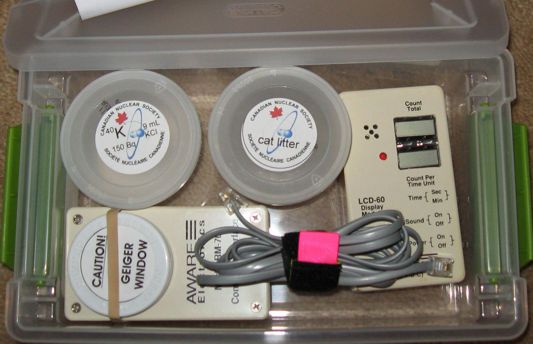
Each kit consists of:
- Aware Electronics RM-70 Geiger detector & a connecting cable;
- Aware Electronics LCD-60 display module powered by an internal 9 V battery (included);
- ~ 9 mL of potassium chloride (NoSalt®) in a plastic container. This corresponds to 150 Bq (bequerel) of 40K (potassium-40), a naturally occurring radioactive isotope;
- A sample of clumping cat litter (bentonite clay) in a plastic container that also contains potassium.
- A copy of the Aware Electronics Manual with supporting information.
To borrow a kit:
Students may obtain the loan of a Geiger Kit by arranging with their science teacher to contact the CNS and make the request on their behalf.
The Canadian Nuclear Society will confirm with the teacher, and the kit will be sent to the teacher. The teacher will be requested to store the packing material for the future return of the kit to the CNS.
To return a kit:
- The student shall return the complete Geiger Kit to the teacher;
- The teacher will contact the CNS by email, and a pre-paid UPS shipping label will be provided as a PDF file;
- The teacher will repackage the Geiger Kit, print and affix the label, and arrange for pickup of the shipment by UPS.
Nuclear-Science Experiments in the Classroom
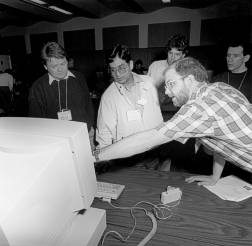
During the Annual Science for Educators Seminars formerly held at AECL’s Chalk River Laboratories, science teachers were introduced to some of the material that is included in the Ionising Radiation Workshop. Other activities included the use miniature cloud chambers, and the use of the Geiger detector to estimate the half-life of Ba-137m produced in a commercially available radioisotope generator.
To address the material needs for classroom use in addition to the Geiger Kit Donation program above, the CNS ECC can assist schools in the acquisition of: cloud chambers; flashlights; uranium-containing rock samples and other radiation sources; a Ba-137 radioisotope generator; smoke detectors.
Teachers will be expected to provide dry ice and alcohol for cloud chambers and an IBM-compatible computer for data acquisition from the Geiger detector.
Note: the Ba-137m generator contains 370 kBq of Cs-137 in excess of the 10 kBq exemption quantity specified by the Canadian Nuclear Saftey Commission. Owners of this source in Canada are required to hold a licence issued by the CNSC.
Download the 1998 handbook Nuclear Experiments in the Classroom (PDF) which describes each experiment in detail. The handbook also provides contacts for obtaining the necessary equipment, as well as persons who can provide more information.
Download the PDF version of the shorter booklet: RADIATION ENCOUNTER!, used as supplementary material at a hands-on cloud-chamber demonstration held at the Ontario Science Centre (Toronto, Ont.) on 2002 January 26th.
